How an athlete can turn unhealthy into healthy perfectionism
Perfectionism is logical. The highly competitive nature of the sport environment accompanies a variety of stressful circumstances such as, injuries, pressure, interpersonal conflict, and an evaluative atmosphere where athletes must deal with others’ and their own personal scrutiny of performance [1, 2]. Your response to these factors can be adaptive or maladaptive, and this explains the ‘fine line’ between healthy or unhealthy perfectionism. Consider Serena Williams for example: She has admitted herself to be a perfectionist. Her comment below reveals how she can use her perfectionism to her advantage, but it is also an example in how someone can fall into the trap of unhealthy perfectionism.
“If I’m not playing well, I do get down on myself because I am a perfectionist…no one takes a loss harder than I do. In any sport. I hate losing more than I like winning.
…But I channel my frustration toward losing into a motivation to learn from my mistakes and use that newfound knowledge to improve for my next match”.
-Former world No.1 tennis player Serena Williams
So what is the theory behind perfectionism?
Perfectionism is a multidimensional personality represented by a strive for flawlessness and setting exceedingly high standards of performance accompanied by overly critical evaluations of one’s self [3]. Hence, why perfectionism can be described as a ‘double-edged sword’ holding both positive and negative characteristics [4]. On the one hand, it can be used as a facilitating factor to boost motivation and develop athletic expertise. On the other hand, it can seek to promote a dysfunctional mindset and self-defeating outcomes characterised by worries, and a fear of failure [5, 6].
The ‘2 x 2 Model’ of Perfectionism [7] is based around these two comparative features of perfectionism and proposes these are differentially organised in each individual:
Evaluative concerns’ perfectionism (ECP):a socially prescribed tendency to perceive significant others as exerting pressure to be perfect, in conjunction with evaluating oneself critically and doubting one’s capacity to reach high standards.
Personal standards perfectionism (PSP):a self-imposed tendency to strive towards perfectionism by establishing high standards and aiming for achievement.
Within the model ECP and PSP interact to create four subtypes that help predict motivational processes and adjustment outcomes.Each of the four subtypes have a differing dominanceof ECP and PSP:
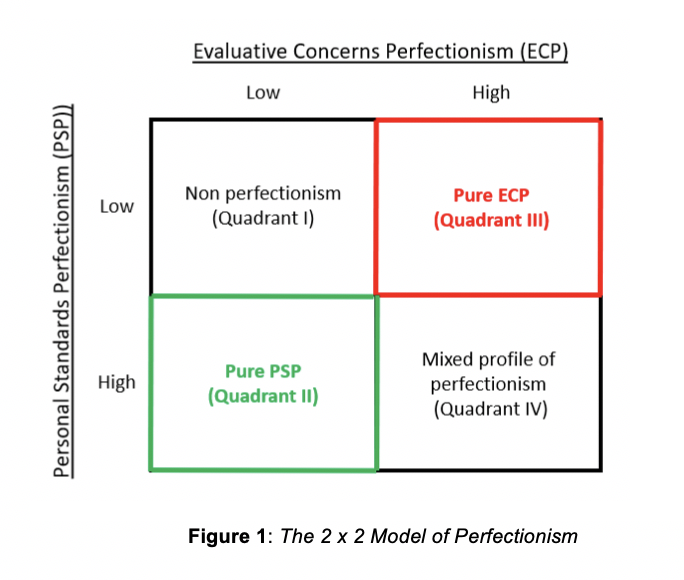
*As the focus is on perfectionism we will disregard non-perfectionism. Also, because the evidence suggests mixed perfectionism (high PSP, high ECP) share similar process and outcomes to pure ECP, we will just refer to pure ECP throughout the blog with our main goal being to reduce athletes’ perfectionistic concerns*
Pure evaluative concerns perfectionism (low PSP, high ECP)-perceive pressure from the external environment (for example contingent rewards and controlling interactions) to pursue perfectionistic standards, but do not value or internalise the standards.
Pure personal standards perfectionism (high PSP, low ECP)-personally valuing and internalising perfectionistic standards, without perceiving external pressure from the environment to achieve these standards.
Characteristics, processes and outcomes of pure PSP and pure ECP
The model proposes that pure PSP is associated with positive characteristics, processes and outcomes, and pure ECP is associated with negative characteristics, processes and outcomes.
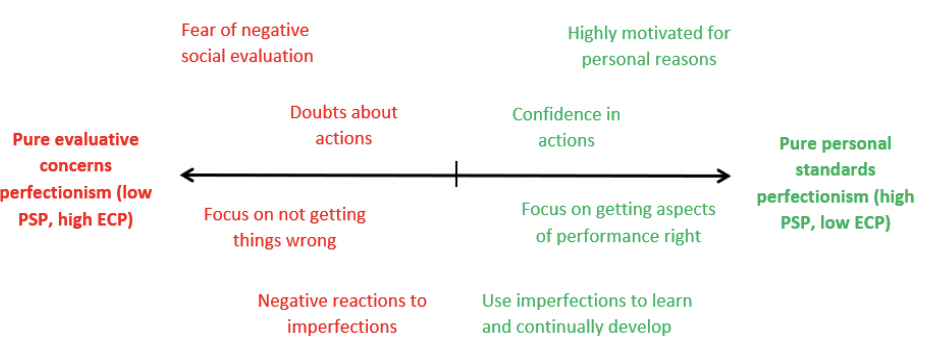
Figure 2:Spectrum of perfectionistic characteristics [8]. Moving towards the right represent pure PSP characteristics and moving towards the left represent pure ECP characteristics
Pure ECP are associated with low levels of self-determination, fear of failure, avoidance-oriented goals, competitive anxiety, negative affect and an increased likelihood of athletic burnout compared to pure PSP [7, 11, 12, 13]. In contrast, athletes with pure PSP adopt more approach goals to performance and a ‘hope for success’ motive, fuelling their desire to demonstrate normative and interpersonal competence e.g. striving to master a task and do better than others [8, 14]. These findings can be explained using various mechanisms including stress appraisal, coping styles and perceptions of success and failure [15]. In terms of stress appraisal, because pure ECP reflects motives to avoid failure, athletes with this style are more likely to see competition as threatening, and less controllable and challenging than an athlete with pure PSP. When trying to deal with the stress, pure ECP perfectionists tend to use maladaptive strategies e.g. ignoring the stressful situation and not dealing with the problem (avoidance coping), and actively trying to reduce the negative emotional thoughts such as fear (emotion-focused coping). Pure PSP perfectionists are more likely to use problem-focused coping aimed at resolving the stressful situation to foster achievement. Finally, pure ECP perfectionists are also more likely to judge performance in terms of absolutes. If they don’t win, it is seen as a complete failure, and anything positive about their performance is discounted(for example finishing 3rdcompared to their previous performance where they finished 5th).
It is understandable that pure PSPmay form a part of a ‘healthy pursuit of excellence’ [9]. With a low presence of ECP, athletes open up opportunities to make additional efforts and achieve the best possible results [10]. In contrast, high levels of ECP accompanied with low levels of PSPmay contribute to a more problematic motivational quality for achievement, and most importantly, represent a serious risk to athlete’s well-being and mental health.
How do I know if I am a healthy or unhealthy perfectionist?
You may be thinking that it’s normal for someone to try to achieve their demanding goals or there is no way to progress by being a slacker. This is true, but it is only one half of the story. Take a look at the example statements below and try and answer them as honestly as you can. Once you have finished, add up how many A’s and B’s you answered.
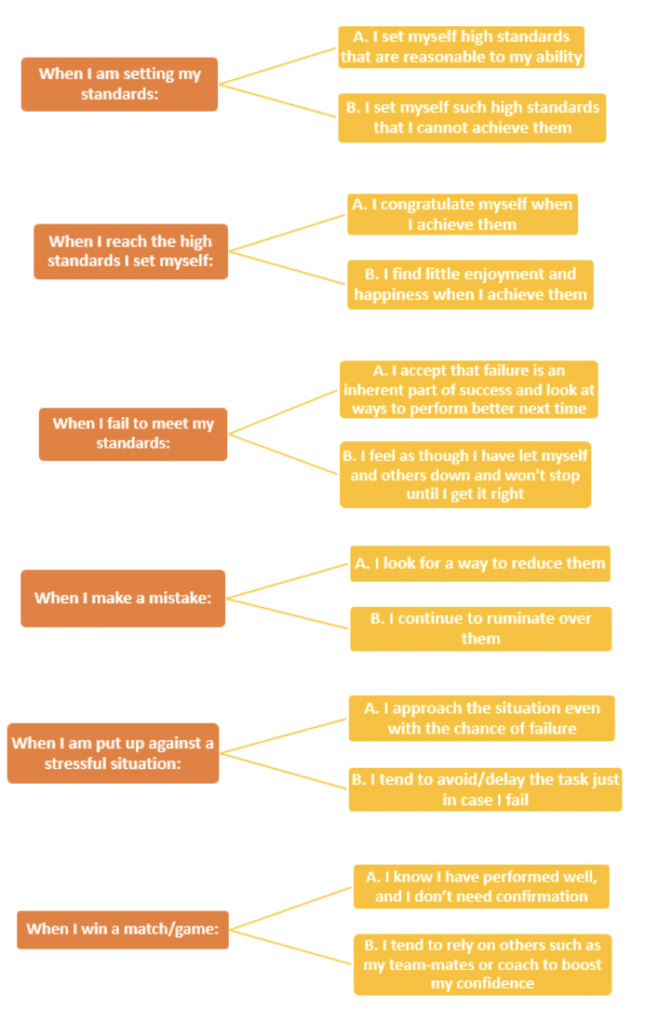
If you answered more B’s than A’s this may suggest an over-dependence of your self-worth on striving and achievement. This does not mean to become a healthy perfectionist you have to stop striving for standards, instead, the goal is to weaken the dependence of your self-esteem on striving and achievement [6, 10].
The techniques underpinned by Cognitive Behavioural Therapy [16] support you to:

To make it a habit of monitoring immediately after the problematic situation, it is useful to keep a diary/log-book somewhere close at hand such as in your sports bag.
2. Questioning personal beliefs will provide you more meaningful information regarding which consequences of your thoughts and behaviours are real. Behavioural experiments are a useful way to identify your unhelpful concerns by testing out predictions about a thought or behaviour. For example, if you are an athlete who believes training to exhaustion is the only way to achieve more, which is very physically demanding, alternatively, planning out a reasonable schedule balanced around training and recovery would be more beneficial for long-term results. Other forms of experimenting include how might others react e.g. team-mates after a loss, or how distressed you will be in a deciding match. To put this into action, a good way is to follow the path below and write down each step:
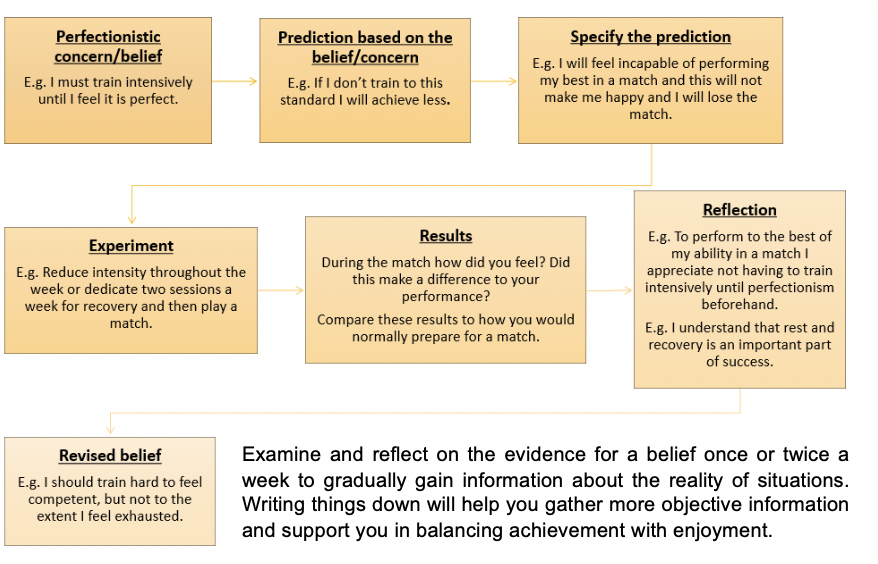
3. Challenging perfectionistic thinking patterns will help alter the way you evaluate your goals and increase your ability to think and behave in more flexible ways. Strategies to achieve this include turning rigid rules into guidelines and noticing the positive:
Rigid rules to guidelines
High levels of perfectionistic concerns tend to accompany rigid and strict rules to measure performance. These rules are often caused by ‘all or nothing’ thinking in which standards are judged in extremes e.g. a complete failure or a complete success, leaving no room for average performance. Even when an athlete does achieve their standard they are likely to not think much of it i.e. no effort was required, and so set an even higher goal. Thus, it is important to develop a new way of evaluating the self to reduce the damage these rules have on self-esteem. We can do this by replacing rigid rules with flexible guidelines and using these as new standards for excellence. The steps below aim to achieve this:
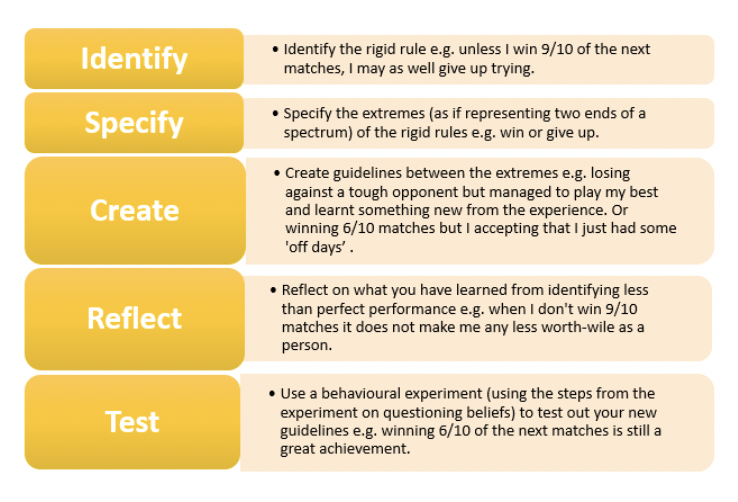
The more you practise your all or nothing thinking the easier it is to see that performance does not fall into one of two extreme categories. This will help you feel more relaxed in your thinking processes and offer you a sense of freedom to enjoy your athletic life. Top tip:to determine whether the goals you set yourself are achievable, ask a friend or team-mate what they think and how they cope when they don’t achieve their goals.
Noticing the positive
Athletes high in perfectionistic concerns get into a habit of paying excessive attention to the negative aspects of their performance e.g. a sprinter getting through qualifying but noticing they had a very poor start and should have been quicker. They also tend to depreciate their efforts when a goal is reached e.g. winning a race but stating it was too easy. These examples can be seen in someone with a healthy strive for success but won’t be regular thinking patterns that lead to a general criticism of oneself. This is because they are more likely to notice equally the negative AND positive aspects of performance despite the outcome. So the aim is to balance out what went well and what you can improve on. To help you do this keep a diary of events over the next weeks and note the following:
Step 1. Identify a situation which would generally cause you negative thoughts i.e. finishing 3rd in a race instead of 1st.
Step 2. Ask yourself are there any positive aspects of my performance that I am not attending to which I can take away e.g. team-mates congratulating my efforts, coach praising me for my good running technique, winning a bronze medal. Also note the lack of negative evidence e.g. no one judging me for coming 3rd.
Step 3. Write down extra information from the situation to broaden your attention, such as the details around you (conversations, weather, canteen food, equipment).
Step 4. Determine the main flaws from your performance and try to change them into areas for improvement e.g. I lost a bit of energy towards the end of the race so I should work on improving my cardiovascular endurance.
Step 5. Evaluate the outcome of having not just focused on the negative aspects e.g. when I reflect upon all the evidence, the race was a success overall and I shouldn’t be so hard on myself. Attending to what went well and external stimuli helps broaden my attention.
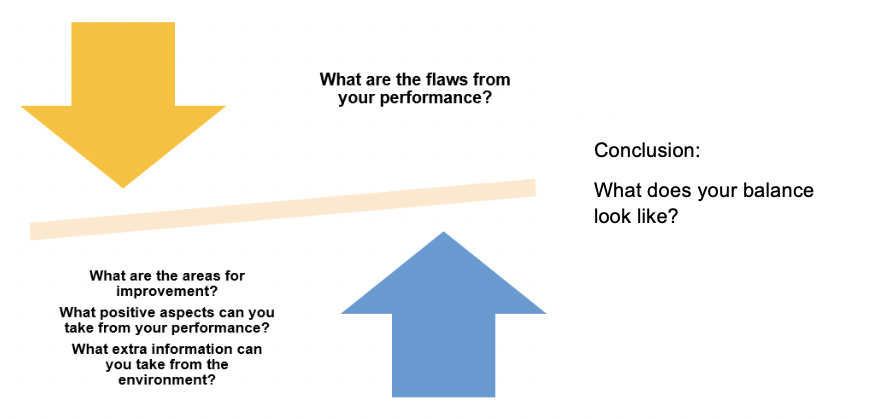
4. To help deal with setbacks
After all, don’t be harsh on yourself! Remind yourself how well you dealt with the slippage and the failures and applaud yourself for that.
Take home messages:
Recognising that ‘perfect’ doesn’t mean stronger and wiser, is a pathway towards a healthier and more meaningful life
OUR PARTNERS